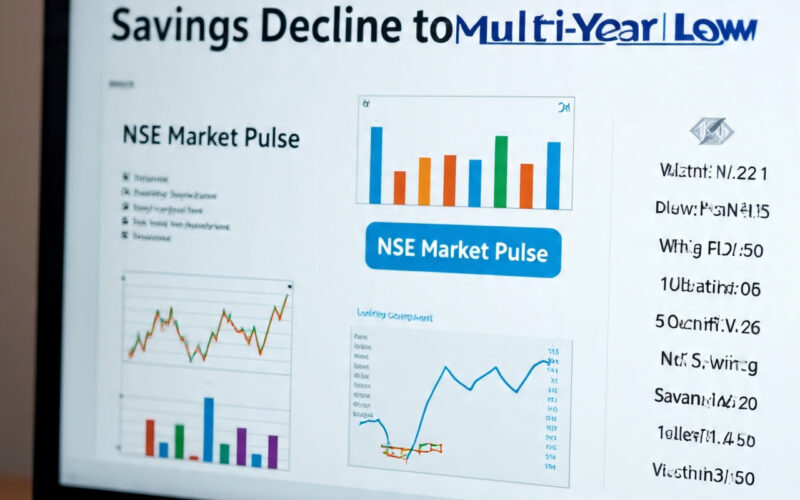Post-COVID consumption driven by credit raises financial vulnerability, analysts warn
#NSEMarketPulse #HouseholdDebt #SavingsDecline #FinancialLiabilities #IndianEconomy #CreditConsumption #HouseholdFinance #DebtVsSavings
Chandigarh: India’s household financial landscape has undergone a significant transformation in recent years, with the latest NSE Market Pulse Report (June 2025) revealing a worrying dip in net household financial savings, even as household debt and credit consumption rise sharply.

According to the report, net household financial savings — which had remained stable between 7% to 8% of GDP from FY12 to FY20 — have plummeted to just 5.2% of GDP in FY24, well below pre-COVID levels. This comes as Indian households increasingly rely on borrowed funds to fuel consumption, raising concerns about long-term financial health and stability.
From Savings Boom to Liability Overload
The fiscal year FY21 saw a temporary spike in savings, reaching 11.7% of GDP, as the COVID-19 pandemic curtailed both consumption and borrowing opportunities. Households turned cautious amid income uncertainties and mobility restrictions, leading to a precautionary accumulation of savings.
However, as the economy reopened and consumption rebounded, household financial behavior shifted dramatically.
-
Household financial liabilities rose sharply from 3.7% of GDP in FY21 to 6.2% in FY24, effectively nearly tripling in value from ₹7.4 lakh crore in FY21 to a staggering ₹18.8 lakh crore in FY24.
-
Consequently, net financial savings fell from ₹23.3 lakh crore at their FY21 peak to ₹15.5 lakh crore in FY24.
This combination of falling savings and rising liabilities underscores the strain on household balance sheets in the post-pandemic economic recovery.
Credit-Fueled Consumption on the Rise
While a decline in net financial savings is concerning, the steady rise in household credit adds another layer of complexity. Household debt, which had hovered around 32–35% of GDP from FY13 to FY20, has seen a steep rise, reaching 42.1% of GDP in FY24.
This increase in credit is closely aligned with a strong rebound in private consumption, which grew at an average rate of 6.7% between FY23 and FY25. Analysts believe a significant portion of this spending boom is being funded through borrowed money, including credit cards, personal loans, and home financing.

“Credit-fueled consumption can provide a short-term economic boost, but it raises concerns about sustainability if income growth does not keep pace,” said a senior economist at NSE. “When liabilities grow faster than assets, households become more vulnerable to economic shocks, interest rate hikes, or job losses.”

Savings Behavior Under Pressure
A key takeaway from the report is the evolving attitude towards savings and borrowing:
-
The decline in financial savings is not just a return to pre-pandemic norms, but a continued fall below historical averages, indicating a structural shift in household behavior.
-
Higher inflation, rising interest rates, urban lifestyle changes, and aspirational consumption patterns are pressuring households to dip into savings or rely on debt to meet expenses.
Some financial planners also point to increased participation in equities and mutual funds, leading households to shift from traditional saving instruments (like fixed deposits or small savings) to riskier investment avenues.
The Policy and Market Implications
This changing financial structure has important implications:
-
For Policymakers:
The decline in net savings can affect the domestic resource base needed for investments. Policymakers may need to revise fiscal strategies and encourage formal savings instruments to rebuild the savings rate. -
For Financial Institutions:
Banks and NBFCs could see an increase in retail credit demand, but also face higher delinquency risks if over-leveraged borrowers face income disruptions. -
For Investors and Markets:
Credit growth and consumer demand may support equity markets in the short term, especially in retail-driven sectors like consumer durables, auto, and housing. However, rising debt levels could signal caution for long-term stability.
Looking Ahead
Experts recommend that households reassess their financial health, limit discretionary debt, and build emergency funds to weather economic uncertainties. Government and financial institutions may also need to strengthen financial literacy programs to promote balanced financial decisions.
With India poised for continued growth, striking the right balance between consumption, savings, and debt will be critical for sustainable prosperity.
Key Highlights at a Glance:
-
Net household financial savings (FY24): 5.2% of GDP (down from 11.7% in FY21)
-
Household financial liabilities (FY24): 6.2% of GDP (up from 3.7% in FY21)
-
Value of household liabilities: ₹18.8 lakh crore in FY24 (vs ₹7.4 lakh crore in FY21)
-
Household debt-to-GDP ratio: 42.1% in FY24 (vs ~34% pre-COVID)
-
Private consumption growth: 6.7% CAGR during FY23–FY25
Hashtags for Awareness and Sharing
#NSEMarketPulse #HouseholdDebt #SavingsDecline #FinancialLiabilities #IndianEconomy #CreditConsumption #HouseholdFinance #DebtVsSavings #PostCovidTrends #PersonalFinance #ConsumptionBoom #FinancialAwareness #EconomicOutlook #NetSavings #RisingLiabilities

